753 NIGHTDOGS
THE EMERGENCE OF THE NIGHTDOG
by David Hancock
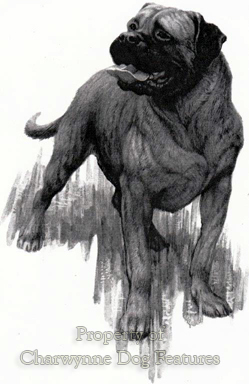 "The first dog I could call my own was a black one, of a cross between the bull and the mastiff...His name was 'Grumbo'...I saw the back of one of the men, his figure stationary, his hands held high above his head, and Grumbo, my faithful, sagacious dog, a yard in front of him, barring his path, couched like a lion in the act to spring, his eyes, not his teeth, fixed on the fellow's throat. The menace sufficed, he stood in terror...and in this position I presently seized him by the collar."
"The first dog I could call my own was a black one, of a cross between the bull and the mastiff...His name was 'Grumbo'...I saw the back of one of the men, his figure stationary, his hands held high above his head, and Grumbo, my faithful, sagacious dog, a yard in front of him, barring his path, couched like a lion in the act to spring, his eyes, not his teeth, fixed on the fellow's throat. The menace sufficed, he stood in terror...and in this position I presently seized him by the collar."
From Recollections – Poachers by Grantley Berkeley, 1850.
The Nightdog Role
The Bullmastiff is usually described in articles on dogs only in its one time role as the gamekeepers' nightdog. Such a description does scant justice to a breed-type which survived centuries of mixed breeding, indicating a strong perennial identity, and of brutal use by man, in the hunting field, the baiting of wild animals and as a butcher's dog, used to pin wayward bulls. The Bullmastiff is also usually described as a Mastiff/Bulldog cross, which overlooks the Bullmastiff's long existence as a large Bulldog or smaller Mastiff before being finally accepted as a breed in its own right. The best summary might be that there are three British mastiff breeds, sharing the same ancestry. In the nightdog role however, this ancestry had its distinct value for the Bullmastiff.
Targeting the Dog
In his The Gamekeeper at Home of 1879, Richard Jeffries recounts the sort of desperate situation in which Keeper's Nightdogs were regularly placed: "In the last party (the squire's) were six men and a mastiff dog; four of the men had guns, the gentleman only a stout cudgel. They came upon the gang (of poachers) in a drive deep in shadow. With a shout the four or five men in the drive or green lane, slipped back behind the trees, and two fired, killing the mastiff dog on the spot and 'stinging' one man in the legs." It is interesting that the poachers made a high priority of killing the dog.
'Terror of all the Idle Boys'
In his classic Dog Breaking of 1909, the esteemed General Hutchinson was writing of a nightdog: "The appearance of the formidable -looking animal, and the knowledge of his powers, more effectually prevented egg-stealing than would the best exertions of a dozen watchers. He was the terror of all the idle boys in the neighbourhood. Every lad felt assured that, if once 'Growler' were put upon his footsteps, to a certainty he would be overtaken, knocked down, and detained until the arrival of the keeper." There is a canine instinct being capitalised upon very effectively.
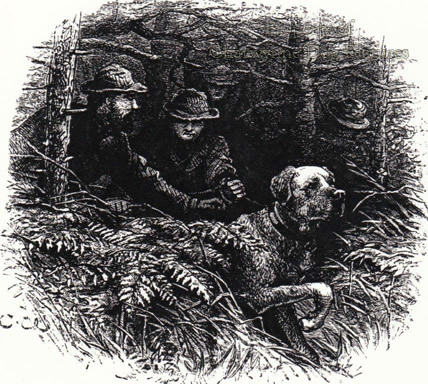 Under Control
Under Control
'Stonehenge', writing in his Dogs of the British Islands of 1878, gave us this view: "...there is probably no variety of the species which combines so much strength and power of doing mischief with such docility and amiability, and hence he is, par excellence, the keeper's dog...every one of experience knows that many keeper's dogs, which are fully half bull, are perfectly under control even with severe provocation..." There is the best possible terminology for the breed standard's words on temperament in the breed!
Importance of Research
Researchers looking at the words of writers in the 19th century, especially the Victorians, need to exercise considerable discernment. Far too many so-called authorities of that period knew little of foreign breeds, seemed to regard British breeds as the source of all foreign ones and constantly referred to breeds in earlier times, when pure-breeding was neither desired nor practised. Writers on Mastiffs have produced more inventions than perhaps any other breed historians. It is important too to keep in mind that writers in the last century came mostly from the educated monied classes in times when class distinction was at its height. Just as Dr. Caius, a scholar not a sportsman, had his leg pulled by the dogmen of his day, so too were far too many 19th century writers out of touch with breeders of dogs not used in the hunting and shooting fields. In this way, sheepdogs, terriers and dogs used by uneducated people were rarely adequately covered, whilst foxhounds, pointers and setters had whole libraries written about them.
Lack of Recognition
Quotes from British writers on dogs at the turn of the century therefore need qualification if they are to have real value. Both Bulldogs and Mastiffs of Bullmastiff conformation are nearly always described as large Bulldogs or small Mastiffs, with hints of interbreeding to justify the size. On the continent, writers, with the exception of the dreaded Buffon, were much more precise and are therefore of greater value. They knew the difference between a 'grosse bullenbeisser' and a 'kleine bullenbeisser', both in appearance and use. Dogs of Bullmastiff conformation and employment were commonplace in 19th century Britain but had no distinctive breed title and therefore no recognition.
Lack of Knowledge
Richard Thornhill, in his The Shooting Directory of 1804, quotes Buffon as stating: "The Bull Dog with the Mastiff produces a mongrel which is called the strong Bull Dog, and is much larger than the real one, and approaches it more than the Mastiff". A more enlightened interpretation would be, not the expression "strong Bull Dog", but Dogue de Forte Race which embraces the chien de nuit or nightdog and the Dogue de Bordeaux. John Lawrence, in his The Sportsman's Repository of 1820, refers to a "Mastiff who might have a dip or two of the Bull Dog blood in him". These writers did not have the knowledge to describe three acknowledged forms of mastiff-type dogs: the large (and heavy) mastiff, the intermediate lighter squarer-jawed dog and the smaller more heavy-headed bulldog.
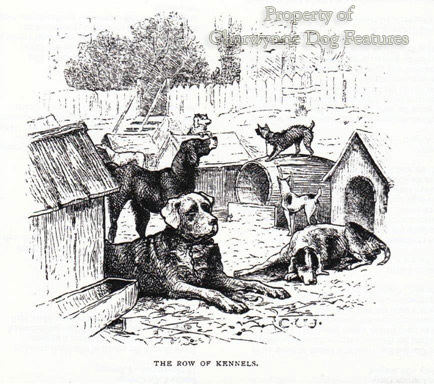 Long in Existence
Long in Existence
In the mid to late 19th century, writers such as 'Idstone' and 'Stonehenge', influential then and now, continued the trend of always referring to this intermediate lighter broad-mouthed dog as a mastiff-bulldog blend and never as a breed-type in its own right. By 1886, 'Stonehenge' was writing in his Dogs of the British Islands (fifth edition), in connection with the Bulldog: "...the crosses in which he has been used are now established." Fanciers of the grosse bullenbeisser on the European mainland would have laughed at such a 'revelation'; there never was a clear distinction between Mastiffs and Bulldogs except by way of size and head. The intermediate form, called the grosse bullenbeisser for centuries, called here the Bull and Mastiff then the Keeper's Nightdog and now the Bullmastiff has long been here. I agree with Count V. Hollander, who wrote in 'The Kennel' of March 1911: "The public know very little of the qualities of the Bull-Mastiff and, what is more, that it has been in existence for some considerable time."
Recognition of an Established Type
For the title Keeper's Nightdog to be utilised in Britain was a significant advance for this distinct type of dog. For the first time it was appreciated that there was a breed-type between the big Mastiff and the smaller Bulldog. It meant that the three sizes of mastiff-like dogs were each accepted in their own right. The ensuing breed title, accepted in due course by the Kennel Club as Bullmastiff, must not be misinterpreted by those persisting with the notion that the Bullmastiff was somehow invented in Edwardian times after an inspired cross between two different breeds. Such an interpretation displays a complete lack of understanding of how the three British breeds: Mastiff, Bullmastiff and Bulldog, came into being. It is significant that the Bullmastiff type predominates in the mastiff breeds of the world, with the French and Spanish breeds and the Boerboel of South Africa being closer to this type than the Mastiff of England.
Unequalled Guard
There were six entries of "Yard or Keeper's Night Dogs" at the 1871 Crystal Palace exhibition. Eight years later, 'Stonehenge' was writing in his The Dog in Health and Disease: "The bulldog (is) an excellent watch, and as a guard unequalled, except perhaps by the bull-mastiff, a direct cross from him." The early use of the breed title is spoiled by the traditional lack of knowledge of broad-mouthed dog history. In his valuable The Dog Book of 1906, James Watson referred to: "Another old breeder of mastiffs for use by keepers was John Crabtree, who while making his rounds as gamekeeper, found a long and low brindle mastiff bitch in a trap...she came from Lancashire, and Crabtree always said she had bulldog blood in her."
 Function Rules
Function Rules
In France such a dog would have been called a chien de nuit or chien du guet, in Germany a grosse bullenbeisser (sometimes a 'boar-lurcher') and in Denmark a Danish dog. Around 1850, in Denmark, Sehested started to re-create the old Danish dog, now called the Broholmer after his estate at Funen. He knew full well that there had been an intermediate mastiff-like dog, in between the Brabanter/Boxer size and the much heavier mastiff type. Only in Britain did the in-between dog lack recognition. Incidentally, gamekeeper Crabtree's long, low, brindle "mastiff" bitch, named 'Duchess' by him, was mated to Holdsworth's 'Lion' of the Bold Hall strain. A bitch from this mating was later mated by Crabtree to Waterton's 'Tiger', a red fawn Great Dane, illustrating very clearly the mixed and often unknown breeding behind the dogs used by gamekeepers.
"In many parts of the country it is the custom for keepers and watchmen to be provided with night-dogs, and useful co-adjutors they make if only they have been properly trained...Usually the Bull-Mastiff is the breed selected for the purpose, and brindle if possible."
Breaking and Training Dogs by 'Pathfinder' 1906
"...it is better to have a very large animal, whose growls alone are somewhat terrifying, and whose size is bound to impose respect. At the same time, growling is not sufficient; the dog must be able and willing at any time to 'go in' at a nod from his master, and he must take his death, if necessary, when called upon to protect him."
'Training a Keeper's Night Dog' from Dog Breaking by 'Wildfowler' 1915
"Shortly before the second war, I read that many of them were employed...in guarding the diamond mines at Kimberley. The fifty that went on sentry duty every night round the square mile of barbed wire fencing that protected the mines, did work that had previously been entrusted to fifty armed men. Only four men had to be used with the dogs"
A Croxton Smith on Bullmastiffs in his Dogs since 1900 of 1950
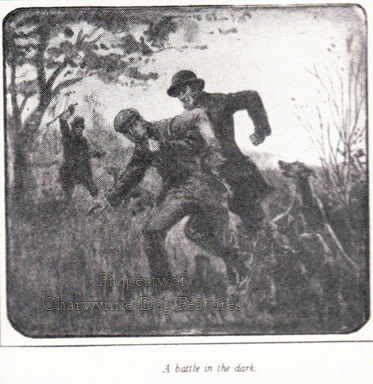 "...the muzzle is deep and broad, showing more Mastiff than Bulldog quality..."
"...the muzzle is deep and broad, showing more Mastiff than Bulldog quality..."
Clifford Hubbard on the Bullmastiff in his Dogs in Britain of 1948
"This breed was dormant for a great many years, but again grew in favour with those who like a noble animal."
Hutchinson's Dog Encyclopaedia of 1934, on the Bullmastiff.
Blended Blood
Of interest to Bullmastiff devotees are the references to bull and mastiff crosses in the last century. In his Dogs of the British Islands of 1878, 'Stonehenge' wrote that: "...the proportion of bull ought to be small, not exceeding one-eighth...a much worst strain in the pedigree of the mastiff is the cross with the bloodhound, which has been tried in order to give majesty to the expression...the temperament is sadly interfered with...the lips are too pendulous and the eye sunken..." There are plenty of present day Mastiffs with such faults and Bullmastiff breeders must be vigilant too.
Bulldogs in Name Only
Of even greater interest are the words of a Captain Garnier, quoted by 'Stonehenge': "By crossing, then, the bulldog with the mastiff, we merely combine two breeds which a century ago were identical...In using the cross, however, it would, of course, be advisable to select a brindled or fallow dog...We have an illustration of the bull cross in King and his produce...the under jaw slightly underhung, a full prominent eye, short muzzle, and square forehead...The shortness of the muzzle makes it look broader than it really is, and the squareness of the forehead makes that part look fuller...in the particular case of King the bull cross has had no very decided effect but that need not prove an objection to that cross, unless it can be shown that the bulldog used was the best of his class. For there are 'bulldogs and bulldogs'; and it is only in the best specimens that the head will measure more round in proportion to their size than the heads of well-bred mastiffs, the squareness of forehead and shortness of muzzle in the bulldog contributing to make their heads look larger and fuller in proportion to their size than they really are."
Bulldogs by Function not Name
It is very important to keep in mind that the word 'bulldog' was once used to describe any dog used in bull-baiting and these dogs would not have resembled the modern breed of Bulldog. The remark of Capt. Garnier that there are "bulldogs and bulldogs" has relevance too for bullmastiff breeders of today. In his 'Itinerary' of 1598, Hentzer was recording: "There is a place built in the form of a theatre, which serves for baiting of bulls and bears; they are fastened behind, and then worried by great English bulldogs..." The latter were clearly not the size of the modern breed of Bulldog.
Baiting Dogs
In his The Every-Day Book, William Hone quotes from 'Zoological Anecdotes' of a lion-bait in Vienna: "In the year 1791, at which period the custom of baiting wild beasts still existed in that city, a combat was to be exhibited between a lion and a number of large dogs. As soon as the noble animal made his appearance, four large bulldogs were turned loose upon him..." A different scholar might have described such dogs as mastiffs but the size of bulldogs clearly varied. In his well-researched Brutes and Beasts, John Swain states that: "The pug-dog cross was successful in shortening the nose, but was unsuccessful from a sporting point of view, as they gave the bulldog that extraordinary placidity of temperament for which the breed is famous." There really are 'bulldogs and bulldogs', as Capt.Garnier once stated!
"The bull-dog differs from all others, even from the mastiff, in not barking as a warning of an attack, but at once grappling with his antagonist, and without in the least estimating their comparative weight and powers. 'We have seen one' says Colonel Smith, 'pinning an American bison and holding his nose down, till the animal gradually brought forward his hind feet, and, crushing the dog to death, tore his muzzle out of the fangs, most dreadfully mangled.'"
'Dogs and their Ways by the Rev. Charles Williams, 1863
 This account has been challenged over the years as being an unlikely feat. But big game hunters provide valuable corroboration. A smaller dog had the advantage when 'pinning', a larger one when 'holding'.
This account has been challenged over the years as being an unlikely feat. But big game hunters provide valuable corroboration. A smaller dog had the advantage when 'pinning', a larger one when 'holding'.
The Bullmastiff's Inheritance
Against a background of Mastiff, Bulldog and nightdog breeding at the end of the last century, is the breed of Bullmastiff any more manufactured than the modern breed of Mastiff or Bulldog? Behind the Mastiff as a recognised breed is Great Dane, Bloodhound, the old fashioned St. Bernard, 'Alpine mastiff', Thibet 'mastiff' and both Bullmastiff and Bulldog blood. Behind the Bulldog is the blood of the Spanish 'alano', introduced by the renowned Bill George, the baiting dogs of mixed and varied ancestry, small Mastiffs and the Pug. Clearly, such mixed blood needs skilful blending if a uniform type is to emerge and then be stabilised.
The Emergent Breed
The immense bravery and boldness of the Bullmastiff was acknowledged early by the leading expert of his day on guard-dogs, Lt.Col.E.H.Richardson, in his Watchdogs of 1924: "The bullmastiff, while not so large, can also be too vehement for average purposes, and takes a male to control him. He has his uses, however, when a man is faced by an exceptionally dangerous and lonely situation at home or abroad. Absolutely undaunted in attack, and with his reputation alone carrying added value, this is a fine breed for special circumstances." This is a remarkable tribute from a man not given to lavish praise and indicates how quickly the 'new' breed's reputation had spread.
Early Breeders
Early pioneer breeders include J.H.Biggs of Osmaston Hall in Derbyshire, W.Burton of Burtonwood kennels in Nottingham, J.H.Barrowcliffe (later president of the Midland Bull-Mastiff Club), H.E.V.Toney, V.J.Smith, J.Barnard and S.E.Moseley. In his The Complete Book of the Dog of 1922, the leading writer on dogs of his time, Robert Leighton, was recording: "...the most popular of all half-breeds, as a watchdog, is the Bull Mastiff, who is almost worthy to be called a distinct breed." In 1924, the Kennel Club gave official recognition to the breed. The Midland Bull-Mastiff Club was registered in 1925 and The National Bullmastiff Police Dog Club in 1926.
Incorrect Pedigrees
Moseley's Farcroft Fidelity was the first winning Bullmastiff, with his Farcroft Silvo being made up as the first Bullmastiff bitch champion. Moseley also bred Mastiffs, one of them at least bearing the Farcroft name, Farcroft Watchman. Moseley, in 1925, was found guilty by the KC of conduct injurious to those interested in canine matters and censured. He had attempted to pass off an illustration of a Mastiff in a well-known book as his Bullmastiff Farcroft Formidable, supplied incorrect pedigrees and obtained an Alsatian bitch puppy by means of a trick. He was an influential but untrustworthy breeder. I would not consider his pedigrees to be accurate.
The Role of Moseley
His breeding formula too doesn't make any sense genetically. He is alleged to have summarised his breeding technique as:
"Taking a mastiff bitch and a bulldog I produce a 50/50. A bitch of these I mate to a mastiff dog and gave me a 75% mastiff 25% bullbitch, which I mate to a 50/50 dog. A bitch from this litter is 62 1/2% mastiff 37 1/2% bulldog. I mate this to a 50/50 dog, and a bitch from this litter I put to a 62 1/2% mastiff 37 1/2% bulldog which gives me approximately my ideal 60% mastiff 40% bulldog."
False Fractions
Now read the words of Bateson in his The Progress of Genetic Research of 1906: "...dogs for example, derived from a cross a few generations back have been spoken of as 1/8 bulldog, or 1/32 pointer blood, and so forth. Such expressions are quite uncritical, for they neglect the fact that the characters may be transmitted separately and that an animal may have only 1/32 of the 'blood' of some progenitor, and yet be pure in one or more of its traits." I suspect that Mr. Moseley bred on the phenotype until by trial and error he obtained consistently a lighter Mastiff. His Farcroft dogs didn't usually display any evidence of Bulldog blood. Bullmastiff breeders in the 21st century must be careful not to produce dogs called Bullmastiffs, but in reality Mastiffs with Bulldog's heads. The Bulldog head is genetically very dominant.
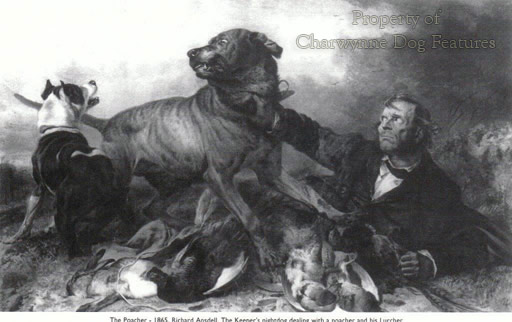 False Records
False Records
Breeding even in registered dogs was not always carefully conducted one hundred years ago. Here are just a few examples from the turn of the century, based on data promulgated in Britain's Kennel Gazette. In 1901, Mr John Fox's Mastiff Clifton Lass was registered as a Mastiff and as having been born in 1894. In 1903, Mr Fox registered Clifton Terror and Clifton Hall as Mastiffs, out of Clifton Lass by Thorneywood Terror. In 1905, Mr W Blackburn registered Ratcher Hill Bessle as a Mastiff, again out of Clifton Lass and by Thorneywood Terror. There were no caveats on the breeds being mated at a time when cross-breds were regularly registered. In 1912, Mr C Richardson registered two Bullmastiffs, Diamond, born in 1911 and Grip, born in 1907. Both these Bullmastiffs came from a mating between Thorneywood Terror and Clifton Lass, previously listed as Mastiffs.
Worthless Records
Even more startling, the pedigree reveals that Clifton Lass gave birth to Diamond when she was 17 years old! Is that likely? Here is just one exposed case in which not only are breeds treated in a cavalier manner but human credulity stretched to the limit. Breeding records like these are worthless, making not only a mockery of the system still being perpetuated today but of every painstaking examination of breeding records of those times. Thorneywood Terror, incidentally, was considered to be the most effective night-dog in Britain, giving demonstrations of man-catching at livestock shows around the country. He was a brindle weighing about 90lbs and had evident Bulldog blood; he was without doubt a prototypal Bullmastiff. He was widely used as a Mastiff sire, of Stanford Busker (born 20 July 1902) and Allestree Judy (born August 1902) for example. There is merit sometimes in crossing two breeds in pursuit of enhanced function or virility but false records help no breed.
Wrong Sires
In April 1921, Sir Roger, a dog sired by Poor Joe (Bullmastiff) and out of Peggy (Bullmastiff) was registered as a cross-breed (Bullmastiff). In August 1921, Poor Jerry, from the same litter was registered as a Mastiff. In 1922, Peggy herself was registered as a Mastiff! King Baldur and Penkhill Lady appear as the same sire and dam in both Mastiff and Bullmastiff registrations. The first Bullmastiff to win a prize at Crufts, Farcroft Fidelity, was actually sired by Shireland Vindictive but was sent for a service from his alleged father Vindictive, the truth only being extracted much later. It also transpired that Shireland Vindictive's sire was in fact a Bulldog called Wellington Marquis, and not Vindictive at all. Farcroft Fidelity had not a little influence on the developing breed of Bullmastiff; are his papers of any value?
Conserving the Real Breed
The Farcroft kennel of Moseley was however undeniably influential in the stabilising of the emerging breed and its introduction to the show circuit. His motto was admirable: "Farcrofts are what Bull-Mastiffs should be -- Faithful and Fearless but not Ferocious. Big enough to be powerful but not too big to be active". He played a leading role in the eradication of Great Dane and smooth St.Bernard crosses. The long trail from big game hunter to heavy hound, then from bullenbeisser to keeper's nightdog, is a remarkable story of how a functional type can survive non-pedigree breeding for centuries to emerge as a distinct type which breeds true.
Wiser Bre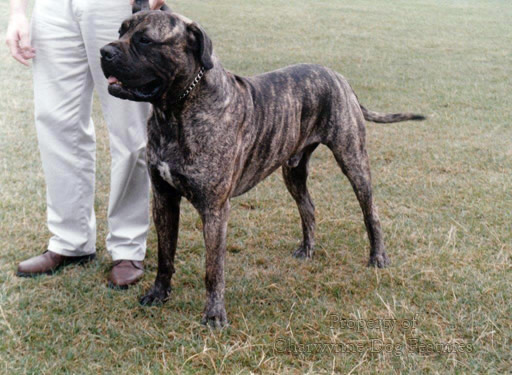 eding
eding
The Bullmastiff fanciers of today owe a great deal to the named and unknown devotees who handed this splendid breed on for us to safeguard in our lifetimes. We should honour their work by breeding dogs which they would have admired: physically and mentally sound and truly functional. The pursuit of show success must never be the over-riding aim. Breeding mainly from dogs awarded prizes by incompetent judges is extremely unwise; breeding your precious bitch to a sire which wins but has no family strength is the sign of a lack of knowledge. But this is the pattern in the British show scene of the 1990s. May the next millennium produce greater wisdom and enhanced skill in the breeders of this fine breed.
"Personally I want no better dog than a Bull Mastiff for police work, and I am ready to back it against any other breed. It may interest you to know that I have made an offer to one of my comrades, who is an Alsationist, to train a Bull Mastiff against an Alsatian to track and be more steady on the trail. I will do all in my power to further this grand all-English breed. Fearless and faithful I have proved it. A gamekeeper friend recommended it to me, and said I should never regret having one. His words were true."
Sgt. Cordy, Police Station, Walsingham, Norfolk. (Quoted in Hounds and Dogs The Lonsdale Library, Vol XIII, Seeley, Service & Co.Ltd, 1932).
"A night-dog should not be less than 80lbs, and if he is 100lbs, strong and active, so much the better. He ought to be able to jump a gate with ease...A night-dog is more valuable for catching a man than fighting one...Teach the dog to rely on himself..."
Mr W Burton, of Thorneywood Kennels, the most knowledgeable night-dog trainer and most experienced user of night-dogs of his day.